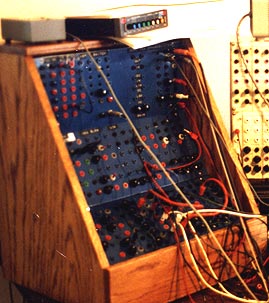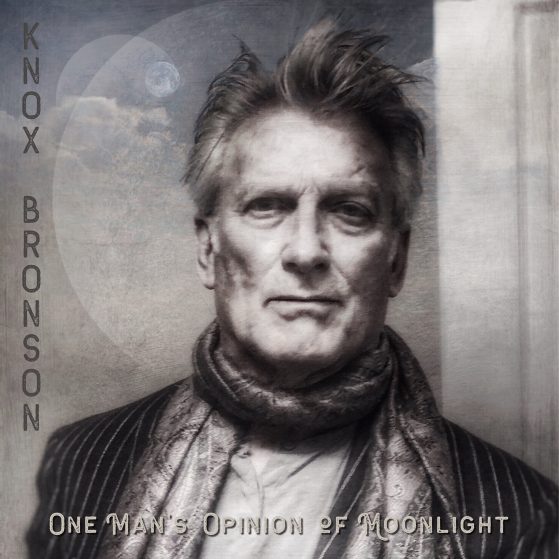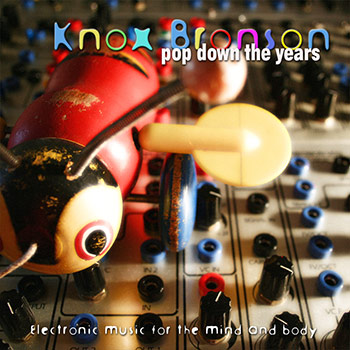I was lucky enough to have Roy’s Blue Serge in my arsenal of synths way back when. It was a fantastic machine, a brilliant collection of modules, devoid of oscillators, suggesting a rather warped view of sound construction on his part! I had plenty of oscillators on other panels, so it wasn’t an issue at all. The initial patch of what was to become “Flight Of The Atom Bee” was done on the Blue Serge. In the subsequent days and weeks I built the rest of the sounds, I used quite a number of modules, many for control voltages, others for some kind of processing. It was an alchemical, exploratory, serendipitous process …
I asked Roy to talk about the Blue Serge for posterity. I finally sold it to a friend, who then sold it, along with eight other panels, to a composer in Germany.
I am going to just put down my recollections in order of their emergence into my present-day consciousness (such as it is).
As the centerpiece of my Bachelor’s studies I had been working night and day in the CalArts electronic music studios, which were centered around two immense Buchla boxes (and several rock-solid, washing-machine sized, verybeautiful-sounding Ampex tape recorders). The Buchla was a blast to use: so flexible, an infinite palette of lovely patterns and textures. But one thing was not optimal: the sound! I don’t know why, but the Buchla tended to sound weak. Feeble. Tentative.
I remember that at one point some young composers visited from UC Riverside (?). One of them presented a tape composition made on a Moog. Though I disdained the Moog as a way too conventional machine the sounds on this guys’s piece were big and fat and juicy and powerful.
Again, I don’t know why this would be. But around this same time I heard that Serge Tcherepnin was making a modular machine similar in concept to Don Buchla’s but even more flexible and it had a muscular sound comparable to Bob Moog’s.
When I say “flexible” I mean that just about any output could be fed into just about any input and something reasonable would happen. For example, Buchla’s oscillators put out a signal in the 1-volt range — “line level”,like a CD player. And they used “audio” (grounded) cables, like a CD player. This put the “audio” signals in a different category from the “control voltages”. You could make an adapter to plug an oscillator into the”control” input to an envelope generator but nothing much would happen because all the “control” circuits had a 5-volt range.So this is all very technical but the point is that Serge’s machine used the same (ungrounded, 5-volt banana) connectors everywhere, so you could plug anything into anything else. For example, you could feed the output of a filter back into its input and it would resonate like a blown reed, just a beautiful tone. My Serge box didn’t even have any “oscillators.” I used filter feedback and envelope generator feedback as my signal sources.To buy my Serge machine I applied for a small ($1,200) student loan — a tiny fraud I justified to myself on the basis of the Necessity of Art.
It was great being down there with a small contingent of extra-serious avant-garde composers. You could get a discount by showing up at Serge’s factory in a really crappy part of Hollywood and soldering the thing together yourself. Serge had even prepared poorly Xeroxed how-to kits for his customers. So there we toiled away like busy bees, listening to Mort Subotnick’s very strange “Four Butterflies” for background music.
The inspiration for my blank panels with no labels came from Gary Chang, who told me he wasn’t going to bother with those decals himself. “A piano doesn’t have labels,” he said. “You just have to know which key is which.” So I just spray-painted all my panels a solid midnight blue – my favorite color. The thing looked like a musical instrument from another planet. People would ask me how in heck I remembered what all those socket and knobs did and I said, “Well, first of all, I put the whole thing together.”
Greg Jones also bought a Serge machine and we used to perform together. How we got hooked up with the proprietors of the Savoy I’m not sure. (We were possibly inspired to try by the Philip Glass Ensemble’s adventurous and electrifying appearance at the Roxy.) Somehow we had heard that the Savoy folks were trying to put together some very eclectic and adventurous sets. I think Cabaret Voltaire had played there or something.
Greg and I showed up and they treated us with extreme skepticism because we looked so straight. But when we played them snippets from our album they said, “OK, this is pretty intense. You’re on.”
There were not a heck of a lot of people there but I was very proud andexcited to be playing in a club in North Beach. Our set was not modified fora rock audience, it was mostly what we had put on the album, very abstract.
But parts of it were a serious fucking wall of noise, and at least a few audience members found it unexpectedly inspiring (at least this was an impression I collected somehow). As a seemingly random arrangement we opened for a Hispanic punk band called the Plugz. At some point in our show someone had complained about the volume; when the Plugz went on the lead guitarist(I don’t remember his name) warned the crowd, “We play really loud, so hold your assholes.”
Though it had been really fun I do not think we ever did another nightclub gig.
Roy’s website can be found here. I should mention that Roy also did the amazing illustrations which adorn and illuminate Flapping. Below is The Bulbous Worlds.



